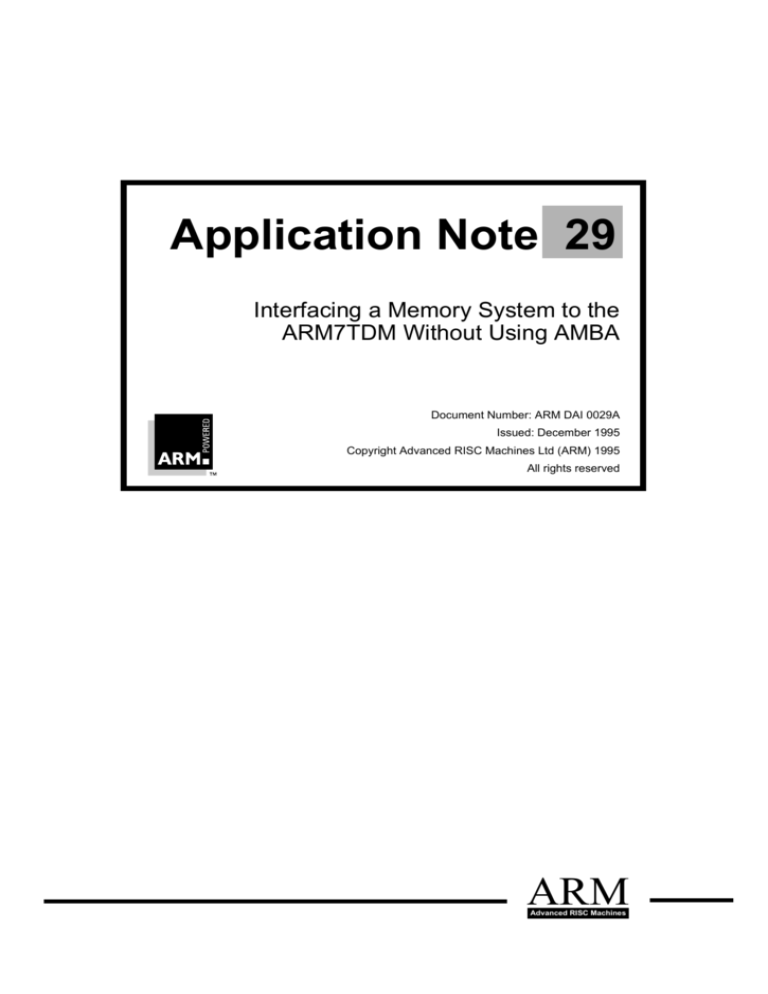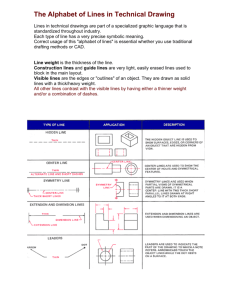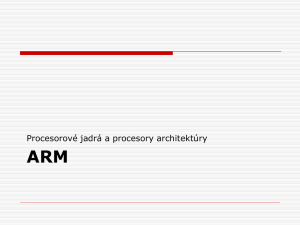
Application Note 29
Interfacing a Memory System to the
ARM7TDM Without Using AMBA
Document Number: ARM DAI 0029A
Issued: December 1995
Copyright Advanced RISC Machines Ltd (ARM) 1995
All rights reserved
ARM
Advanced RISC Machines
Proprietary Notice
ARM, the ARM Powered logo, EmbeddedICE are trademarks of Advanced RISC Machines Ltd.
Neither the whole nor any part of the information contained in, or the product described in, this
application note may be adapted or reproduced in any material form except with the prior written
permission of the copyright holder.
The product described in this application note is subject to continuous developments and
improvements. All particulars of the product and its use contained in this application note are
given by ARM in good faith. However, all warranties implied or expressed, including but not
limited to implied warranties or merchantability, or fitness for purpose, are excluded.
This application note is intended only to assist the reader in the use of the product. ARM Ltd shall
not be liable for any loss or damage arising from the use of any information in this application
note, or any error or omission in such information, or any incorrect use of the product.
Change Log
ii
Issue
Date
By
Change
A
Dec 95
AMP/PN/AP/EH
Created
Application Note 29
ARM DAI 0029A
Interfacing a Memory System to the ARM7TDM Without Using AMBA
Table of Contents
1
Introduction
2
2
ARM7TDM Bus Fundamentals
3
3
Overview of an Example Memory System
9
4
Conclusion
Application Note 29
ARM DAI 0029A
20
1
Interfacing a Memory System to the ARM7TDM Without Using AMBA
1
Introduction
This application note describes how to build a typical SRAM memory system around
the ARM7TDM, without using AMBA.
There are many possible ways of doing this. Different approaches should be used,
depending on the size (width) of the memory system, the type of memory to be used,
and whether this is on or off chip. When deciding on the memory system to use, cost
and system performance must be balanced.
This application note is divided into two major sections.
•
A description of the ARM7TDM bus interface. All major facets of bus
interfacing are described from clocking strategies, through bus configuration
and timing, to memory access control.
•
A detailed example, showing how a typical memory system may be designed.
The example assumes a little-endian system, using only SRAM and ROM.
ARM has developed a bus architecture called AMBA, the use of which will improve
expandability, greatly ease system design, and help testing—particularly in
applications that require multiple bus masters.
ARM recommends the use of AMBA for the design of systems based around the ARM.
However, this application note explains how to interface the ARM7TDM to a memory
system without using the AMBA methodology.
2
Application Note 29
ARM DAI 0029A
Interfacing a Memory System to the ARM7TDM Without Using AMBA
2
ARM7TDM Bus Fundamentals
2.1
Bus clocking
There are two relevant signals, MCLK and nWAIT. MCLK times all processor activity
in normal modes of operation. The static nature of the ARM allows external circuitry to
stretch either phase of the clock for slow peripheral accesses. A typical scheme would
be to employ an external PAL fed with a 40 MHz clock which generates a 20 MHz
clock, stretched as required. This technique may prove difficult to use in some
designs. This phase stretching is shown in Figure 1: Phase stretching.
MCLK
nWAIT
Internal_Clock
phase 1
phase 2
phase 1
phase 2
Figure 1: Phase stretching
An easier and more common alternative to having a high frequency clock within the
system is to use nWAIT in conjunction with MCLK. nWAIT is ANDed internally with
MCLK, so to avoid truncated phase2 (high) cycles, nWAIT can only be changed safely
during the clock low period (phase1). As a result, the nWAIT technique can only be
used to stretch the clock low period. This technique is shown in Figure 2: nWAIT
technique.
MCLK
nWAIT
Internal_Clock
phase 1
phase 2
phase 1
phase 2
Figure 2: nWAIT technique
Application Note 29
ARM DAI 0029A
3
Interfacing a Memory System to the ARM7TDM Without Using AMBA
2.2
Data and address buses
Bus timing
The ARM address bus can operate in a pipelined or depipelined configuration. This is
controlled via the APE signal.
APE = 0
depipelined addresses
APE = 1
pipelined addresses
For interface to SRAM or ROM systems, APE should be tied permanently LOW
ensuring that the address is stable throughout the memory cycle. Memory systems
using DRAM, however, can benefit from the earlier valid address timing available
when APE is HIGH. Address timing using APE is shown in Figure 3: De-pipelined
addresses.
MCLK
APE
nMREQ
SEQ
A[31:0]
D[31:0]
Figure 3: De-pipelined addresses
4
Application Note 29
ARM DAI 0029A
Interfacing a Memory System to the ARM7TDM Without Using AMBA
Bus control signals
ALE:
Address Latch Enable.
This signal controls transparent latches on the address bus. ALE
allows the ARM7TDM to be interfaced to ROM and SRAM. Holding
ALE LOW stretches the valid period of the address. Addresses can
only therefore change with ALE HIGH. Note that APE offers a more
convenient mechanism to address ROM and SRAM on the
ARM7TDM and the use of ALE is not recommended.
This timing is shown in Figure 4: Use of ALE.
MCLK
phase 1
phase 2
ALE
APE
A[31:0]
D[31:0]
Figure 4: Use of ALE
Application Note 29
ARM DAI 0029A
5
Interfacing a Memory System to the ARM7TDM Without Using AMBA
2.3
Memory access control
Memory access control signals
nMREQ:
Memory request.
This is an active LOW signal which indicates a memory access in the
following cycle.
SEQ:
Sequential Addressed Access.
This is an active HIGH signal which indicates that the address used
in the following cycle is either the same as or one operand greater
than the current address. The indicator is applicable to both word and
halfword accesses.
nRW:
Not Read/Write.
This signal differentiates between memory read and write accesses.
LOCK:
Locked Operation.
This signal indicates that a swap instruction is in progress, and that
the following two cycles are indivisible.
MAS[1:0]: Memory Access Size.
The core allows byte, halfword and word accesses. The size of the
transfer is determined by the MAS[1:0] pins as follows:
MAS[1:0]
Transfer Size
00
Byte
01
Halfword
10
Word
11
Reserved
Table 1: MAS[1:0] transfer size
Note that data can be any size and the processor always produces a byte address, but
instructions are either word (4 bytes) or halfwords (2 bytes). When word instructions
are fetched, address bits A[1:0] are undefined, and when halfword instructions are
fetched, A[0] is undefined.
When data reads are performed on byte and halfword data, the memory system
controller may ignore the sizing information and present the whole word. The
ARM7TDM then extracts the correct byte or halfword from the data.
When byte or halfword writes occur, the ARM7TDM broadcasts the byte or halfword
across the whole of the bus. The memory system controller must then examine
address bits A[1:0] to enable writing to the addressed byte or halfword.
6
Application Note 29
ARM DAI 0029A
Interfacing a Memory System to the ARM7TDM Without Using AMBA
The timing of these memory access control signals is shown in Figure 5: Memory
access control signal timing.
phase 1
MCLK
phase 2
Cycle Type
nMREQ,SEQ
Address
A[31:0]
Access Type
nRW,MAS[1:0]
Data
D[31:0]
Figure 5: Memory access control signal timing
Having examined the memory access control signals, it is now possible to provide a
classification of the various memory cycles types. These can be identified by the state
of the signals nMREQ and SEQ. The result of enumerating and classifying the
combinations is shown in Table 2: Memory cycle types.
nMREQ
SEQ
Next Cycle
0
0
nonsequential (N)
0
1
sequential (S)
1
0
internal (I)
1
1
coprocessor (C)
Table 2: Memory cycle types
non-sequential bus cycle
is an access to a memory location whose
address is unrelated to the address used in
the preceding cycle
sequential bus cycle
is an access to or from an address which is
either the same as the address in the
preceding cycle, or is one word or halfword
after the preceding address.
internal cycle
indicates that the processor is not requesting
an access, and is performing some internal
function
coprocessor cycle
indicates communication via the data bus
with a coprocessor, but requires no action
from the memory system.
Application Note 29
ARM DAI 0029A
7
Interfacing a Memory System to the ARM7TDM Without Using AMBA
2.4
Interfacing ARM7TDM to 16-bit or 8-bit memory
ARM7TDM has architectural features that allow it to be successfully interfaced to 32,
16 or 8-bit wide memory systems. Interfacing to 32-bit wide memory is straightforward;
how the processor may be interfaced to sub32-bit memory systems is more
interesting. A memory controller can use the MAS[1:0] signals to control the number
of fetches to or from the memory system. The ARM7TDM has internal latches to allow
32-bit instructions to be built up from sequential fetches to sub32-bit memory. The byte
latch strobes BL[3:0] control these latches. When the appropriate byte lane strobe is
HIGH, the data is latched for that byte on the falling edge of MCLK. The use of nWAIT
does not affect the operation of the byte lane strobes.
8
Application Note 29
ARM DAI 0029A
Interfacing a Memory System to the ARM7TDM Without Using AMBA
Overview of an Example Memory System
A typical memory system (see Figure 6: Typical memory system) consists of a small
amount of fast on-chip 32-bit SRAM, usually located at the bottom of the ARM memory
map. This is ideal to provide the performance required to handle exceptions
(especially the fast interrupt, FIQ). In addition to the on-chip SRAM, there may be a
larger amount of off-chip SRAM, only 8 or 16 bits wide to save system costs. Also,
there will usually be an area of ROM holding the application software. This may only
be 8 bits wide. A system such as this, utilizing only SRAM and ROM, may have the
APE signal tied LOW, such that the address pipeline is disabled. The timing presented
by this configuration is suited to these types of memory devices.
ASIC/ASSP
32-Bit
SRAM
16-Bit
SRAM
8-Bit
ROM
Peripherals
A[27:0]
A[31:0]
D’[16:0]
D[31:0]
Memory
Controller
3
ARM7TDMI Core
Figure 6: Typical memory system
The three different memory types described above will all have different performance
characteristics. ROM is essential for a stand alone product, but generally suffers from
poor access speeds. This will be exaggerated by the narrow size of the ROM, as two
accesses are required to read one Thumb instruction from an 8-bit wide device, and
four to read one ARM instruction.
To get round the problem of slow ROM, the initialization routines could copy the
application from the ROM into the 16-bit wide off-chip RAM. The RAM will generally
be faster than the ROM, and the number of accesses required will be halved due to
the increased bus width.
Application Note 29
ARM DAI 0029A
9
Interfacing a Memory System to the ARM7TDM Without Using AMBA
Performance critical routines benefit from being written or compiled in ARM code,
rather than Thumb code (assuming that 32-bit memory is available). The fast 32-bit
on-chip SRAM allows these routines to run at the maximum possible speed, for the
best performance. Placing this RAM at the bottom of the ARM memory map allows
exceptions to benefit from the performance, because any exception will branch
through the vector table, in ARM state. Indeed, the FIQ handling routine can be placed
at the top of the vector table, saving the need for a further branch.
An example ARM memory map is shown in Figure 7: Memory map. Note that the
areas of the memory map are not necessarily fully decoded. For example, the external
ROM may only be 128Kb, but will be multiple-addressed in the 32 to 64 Mb range.
Normal
4Gb
Reset
4Gb
Unallocated
96Mb
Unallocated
96Mb
Peripherals
64Mb
Peripherals
64Mb
External ROM
(128k x 8)
32Mb
External ROM
(128k x 8)
32Mb
External SRAM
(512k x 16)
8Kb
0Mb
Internal SRAM
(2k x 32)
External ROM
(128k x 8)
0Mb
Figure 7: Memory map
Using noncontiguous memory can be an advantage, because sequential memory
access can be assumed to be accessing the same memory device(s) and as such, the
decode time for the chip select signals need not be considered. This allows a faster
memory access cycle. Any nonsequential memory accesses (such as branches) could
indicate different memory devices will be selected and hence additional time may be
required to allow for the decoding of chip select signals. This could result in the
necessary addition of a wait state.
If contiguous memory were used, the memory controller/decoder would need to know
the address of the boundaries, so that additional time can be added to sequential
memory accesses that cross these boundaries. The additional logic required to check
for this may even slow the system sufficiently that wait states will need to be added for
every cycle. Alternatively, every memory access could be considered nonsequential
and the decoding time of the chip select signals added to every memory cycle. This
may also result in reduced performance due to added wait states.
10
Application Note 29
ARM DAI 0029A
Interfacing a Memory System to the ARM7TDM Without Using AMBA
In the example, however, the internal 2k x 32 internal SRAM overlays the external
RAM allowing code or stacks to flow from internal memory to external memory, if
necessary. Additional logic in the memory controller can check for the last memory
location in internal memory, and force a nonsequential memory access on the
following access cycle.
One disadvantage of having RAM at the bottom of the memory map, is that the
exception vectors (in particular the Reset vector) will not be set up at power-up. For
this reason, a reset memory map is specified, where the ROM is mapped into the
bottom of memory (in addition to its usual memory location). This should contain a set
of initialization vectors, which are used after reset. The Reset vector should branch to
the real (normal) ROM area, where the initialization code will begin. Some mechanism
(such as a write to a specific memory location) can be used to revert the memory map
to normal, and the required exception vectors can then be copied into the RAM for use.
3.1
32-bit Internal SRAM
Interfacing a small amount of on-chip SRAM is relatively straight-forward, and is not
discussed in detail here.
The SRAM is usually very fast, and benefits further from not incurring delays
introduced by I/O pads when driving off-chip. However, as it may be a precious
resource, it should be used wisely for high performance code or frequently accessed
variable storage.
If the RAM is placed at the bottom of the memory map, some mechanism must exist
to provide the ARM with a valid Reset vector after power-up. Therefore, either an
internal or external area of ROM must be mapped over the RAM, and the RAM must
be temporarily disabled. During initialization, the RAM can be restored, and valid
exception vectors copied into the vector table at the bottom of the RAM.
Alternatively, the reset vector may be loaded via the JTAG interface, eliminating the
requirement for ROM.
An important point to remember is that the memory controller must be able to identify
sub-word writes to the SRAM, and ensure that the byte write strobes (usually called
BWE[3:0]) are only activated for the relevant bytes. There is no need to take specific
action on sub-word reads, as the ARM extracts the required byte(s) from the word.
A memory controller will be required to drive the appropriate control signals. This will
usually contain a state machine similar to the one shown in Figure 8: Memory
controller state machine on page 12. Notice that nMREQ and SEQ are identified to
determine whether the next memory cycle will be sequential, nonsequential or internal,
and hence whether to allow time for address decoding. This is discussed in a later
section.
3.2
16-bit wide external SRAM
With 16-bit wide SRAM, each ARM instruction requires two memory accesses; Thumb
instructions can be read in a single memory access. However, off-chip RAM is
generally slower than the on-chip SRAM, so wait-states may need to be added at high
clock speeds. This can be achieved either through the nWAIT input (which can only
add an integer number of clock cycles) or by modulating the MCLK clock through
Application Note 29
ARM DAI 0029A
11
Interfacing a Memory System to the ARM7TDM Without Using AMBA
some other logic (where it is possible to change the clock cycle time seen by the ARM
by fractions of the clock period, and so is more time efficient). This example will
consider the former, simpler method.
The diagram in Figure 9: 16-bit RAM arrangement shows the arrangement of
external 16-bit SRAM connected to a device containing an ARM7TDM core, an
appropriate memory controller and some peripherals.
nMREQ
Ncyc
Icyc
nOE=1
BWE[1:0]=B’11
nWAIT=0
nDE=1
BWE[1:0]=B’11
/nMREQ & /SEQ
/nMREQ & SEQ & /nRW
/nMREQ & SEQ & nRW
Read1
/nMREQ & /SEQ
nDE=0
BL[3:0]=B’1111
BWE[1:0]=B’11
nRW
/nRW
nMREQ
/nMREQ & SEQ
nMREQ
/nMREQ & /SEQ
Write1
nDE=1
BL[3:0]=B’1111
BWE[1:0]=y
/nMREQ & SEQ
Where y is a function of A[1:0] and MAS[1:0].
Figure 8: Memory controller state machine
12
Application Note 29
ARM DAI 0029A
Interfacing a Memory System to the ARM7TDM Without Using AMBA
The state diagram only shows the case of single cycle memory (32-bit on-chip SRAM).
The state machine will need to be extended to allow the slower access times of the
off-chip SRAM to be considered. In this example, two clock cycles are required for a
sequential access, and one further cycle for a nonsequential access. A separate
counter may be used to hold the state machine in the read or write state for the
required time, and to drive nWAIT.
The state machine will also need to consider MAS[1:0] to determine whether one
memory access (for byte or halfword) or two accesses (for word) will be required, and
hence how long to hold the ARM7TDM while the word is built up.
D’[15:0]
D[31:16]
D’[15:0]
D[15:0]
D[31:16]
D’[15:0]
A[27:2]
A[31:0]
nWAIT
A’[1]
16-Bit
SRAM
nOE
BWE[1:0]
nCS
D[31:0]
D[15:0]
Memory
MAS[1:0]
Controller
BL[3:0]
nRW
ARM7TDM
Core
nMREQ, SEQ
MCLK
Board Level Logic
Logic Within ASIC/ASSP
Figure 9: 16-bit RAM arrangement
Application Note 29
ARM DAI 0029A
13
Interfacing a Memory System to the ARM7TDM Without Using AMBA
Extensions to the state machine to access 8-bit wide ROM are discussed in 3.3 8-bit
wide external ROM on page 19.
It is important that the memory controller state machine is operating synchronously
with the ARM7TDM core, to ensure nWAIT is changed within the timing constraints
with respect to MCLK, ie. while MCLK is LOW.
In addition to the memory controller, there is a multiplexer and buffer arrangement on
the data bus. These ensure that the correct halfwords or bytes are presented to the
narrow external memory (for writes), and that the 16-bit bus from the memory is
presented to both the upper and lower halfwords of the ARM7TDM input bus (for
reads).
During a 16-bit, sequential read (a Thumb instruction, for example), the memory
controller determines from MAS[1:0] and nRW that a halfword is about to be read.
SEQ HIGH indicates that the memory cycle is sequential. Figure 10: Signal timing
during a read shows the timing of the signals during the read.
14
Application Note 29
ARM DAI 0029A
Interfacing a Memory System to the ARM7TDM Without Using AMBA
MCLK
2 Clock cycles
APE
nMREQ
SEQ
s-cycle
nRW
B’01
MAS[1:0]
address valid
A[31:0]
A’[1]
A[1]
BL[3:0]
0xF
nWAIT
nCS
B’11
BWE[1:0]
nOE
t ACC
D[31:16]
D’[15:0]
D[15:0]
D’[15:0]
Figure 10: Signal timing during a read
Note the following points:
•
The 16-bit data word takes two MCLK cycles (one wait state) to be read into
the core. The SRAM access time is such that two clock cycles are required.
The time taken for address decoding can be ignored in this case, as this is
only relevant to nonsequential accesses in this memory system.
•
A single OE output enable signal is derived, to drive both byte-wide SRAM
devices simultaneously. During a byte read, for example, the ARM core will
select only the appropriate byte.
Application Note 29
ARM DAI 0029A
15
Interfacing a Memory System to the ARM7TDM Without Using AMBA
•
Two halfword buffers on the data bus input path drive the same halfword of
data onto both halves of the data bus. Instructions are read from alternating
halves of the input data bus, which can be determined from the value of
address bit A[1] and the endianism of the system. It is often more convenient
to drive the data onto both halves of the bus, but system power consumption
may be increased.
• Address bit A’[1] from the memory controller is derived from A[1]. A[1] cannot
be used directly, as the memory controller will need to control this signal for
32-bit memory accesses to the narrow memory system (see later).
Figure 11: 8-bit nonsequential write shows the timing diagram for an 8-bit,
nonsequential write to the same memory system (caused by a store byte instruction,
for example).
MCLK
3 Clock cycles
nMREQ
SEQ
n-cycle
nRW
MAS[1:0]
A[31:0]
B’00
address valid
A’[1]
A[1]
BL[3:0]
0xF
nWAIT
nCS
BWE[1:0]
B’11
Function of A[0]
B’11
nOE
D’[15:0]
Valid Byte Data
Figure 11: 8-bit nonsequential write
16
Application Note 29
ARM DAI 0029A
Interfacing a Memory System to the ARM7TDM Without Using AMBA
Note the following points:
•
The 8-bit data word takes three MCLK cycles (two wait states) to be written to
the memory system. The SRAM access time is such that two clock cycles are
required, and the third clock cycle is required to allow for address decoding
which would not be necessary for sequential memory accesses.
•
The multiplexer is driven by the memory controller (as a function of A[1] and
the system endianism), which directs the appropriate byte(s) onto the memory
devices.
•
Two separate Byte Write Enables, BWE[1:0], are used to latch data into the
memory. Both of these will be simultaneously active during a halfword write,
but only one of these is active during a byte-wide write operation. The active
byte write enable strobes are determined by A[0] and the size of the data
transfer, identified by MAS[1:0].
•
The BWE[1:0] strobes are also derived from MCLK to ensure data setup and
hold times are observed. This can be seen in the timing diagram, as the byte
write enable strobes going (inactive) HIGH very soon after the falling edge of
MCLK.
Figure 12: 16-bit wide memory read shows the more complex case where a 32-bit
value is being read from 16-bit wide memory. This could be due to an ARM instruction
being read, or a load into a 32-bit register.
Application Note 29
ARM DAI 0029A
17
Interfacing a Memory System to the ARM7TDM Without Using AMBA
MCLK
5 Clock cycles
nMREQ
SEQ
n-cycle
nRW
B’10
MAS[1:0]
address valid
A[31:0]
A’[1]
0x3
BL[3:0]
0xC
nWAIT
nCS
B’11
BWE[1:0]
nOE
D’[15:0]
D[31:16]
t ACC1
t ACC2
D’[15:0]
D[15:0]
D’[15:0]
D’[15:0]
Figure 12: 16-bit wide memory read
Note the following points:
•
18
MAS[1:0] denote a word size data transfer. All word accesses must be word
aligned, and so the values of A[1:0] from the ARM can be ignored (assumed
zero). A'[1] from the memory controller is initially driven LOW (for a
little-endian system). nWAIT is driven LOW (active) to add a number of wait
states and to stop the core from trying to use the instruction during its
assembly.
Application Note 29
ARM DAI 0029A
Interfacing a Memory System to the ARM7TDM Without Using AMBA
•
Once again, both halfword buffers on the data bus input path drive the same
halfword of data onto both halves of the ARM data bus. During the first half of
the memory access cycle, Byte Latch signals BL[3:2] are LOW (closed) and
BL[1:0] are HIGH (open), which allow the lower two bytes into the ARM to be
latched on the falling edge of MCLK. Note that MCLK is used to drive the byte
latches before it is gated with nWAIT and so will operate the latches even
when nWAIT is LOW. Data presented to the upper half of the ARM data bus
will be ignored, as the latches are closed.
•
After the first halfword has been read, the memory controller changes A'[1] to
HIGH, allowing the memory system to make the upper half of the data word
available. BL[1:0] will close (LOW) to protect the first halfword already
latched, and BL[3:2] will open.
•
nWAIT will go HIGH (inactive) at the end of the second memory access. This
will allow the ARM core to finish the memory cycle, and the whole 32-bit word
will be latched into the ARM.
32-bit writes to 16-bit memory operates in a similar manner to the read shown in
Figure 11: 8-bit nonsequential write. The multiplexer drives the appropriate half of
the ARM data bus onto the memory devices, and A'[1] will increment to ensure the
halfwords are written into the SRAM correctly. Use of the byte latch control signals is
not applicable during writes.
3.3
8-bit wide external ROM
We have shown how a 16-bit memory system can be used to build up 32-bit words in
the ARM core, using the byte latch controls, BL[3:0]. This concept can be carried
further, to build up words or halfwords from a single byte-wide device.
ROM devices are usually very slow, and may require several wait states to be added
for a single ROM access. As well as the need to perform up to four ROM accesses to
read one word, it is clear that many wait states may need to be added for each memory
cycle.
A new sequence of states needs to be added to the memory controller state machine
to ensure sufficient delays are introduced for each ROM access. Further, the number
of ROM accesses required for each memory cycle needs to be determined from
MAS[1:0].
Since the memory controller needs to address four individual bytes in the ROM device,
two low order address bits will now be required, A'[1:0]. In a little-endian system, these
will generally increment from 0 to 3, opening each byte latch from BL[0] to BL[3] in
turn, latching each byte into the ARM. In a big-endian system, the order of bytes will
be reversed.
As with the 16-bit example, the data from the ROM can be broadcast across the whole
of the ARM data bus. In this case, four byte-wide buffers will be needed to drive the
same byte value on each byte lane of the ARM. Multiplexers can be used to allow both
8 and 16-bit memories to use the same ASIC/ASSP data bus, selected by the memory
controller.
Application Note 29
ARM DAI 0029A
19
Interfacing a Memory System to the ARM7TDM Without Using AMBA
Obviously there is no requirement to perform writes to the ROM (unless a Flash type
system is employed), but this condition should be considered during the design to
ensure there is no possibility of a bus clash.
4
Conclusion
This application note has highlighted some of the major considerations when
designing a memory system around the ARM7TDM core. The points made should be
deliberated when building an ARM7TDM based system. The memory controller state
machine was also introduced, with pointers on how to extend the outline design to
provide support for different types of memory system.
The following issues were covered:
20
•
Use of fast on-chip SRAM for exceptions and high performance routines.
•
Substitution of on-chip RAM with ROM, after a system reset.
•
Using nMREQ and SEQ signals to improve the efficiency of address
decoding.
•
Addition of wait states using nWAIT, to allow for slower memory cycles.
•
Use of the byte latches, BL[3:0] to build up larger operands from bytes or
halfwords.
•
Using A[1:0] and MAS[1:0] in the memory controller to generate the
appropriate byte write enable (BWE[3:0]) strobe.
•
The use of buffers and multiplexers to steer the correct bytes into the correct
byte lanes between the ARM and the memory system.
Application Note 29
ARM DAI 0029A
Interfacing a Memory System to the ARM7TDM Without Using AMBA
Application Note 29
ARM DAI 0029A
21
ENGLAND
GERMANY
Advanced RISC Machines Limited
Fulbourn Road
Cherry Hinton
Cambridge CB1 4JN
England
Telephone:+44 1223 400400
Facsimile:+44 1223 400410
Email:info@armltd.co.uk
Advanced RISC Machines Limited
Otto-Hahn Str. 13b
85521 Ottobrunn-Riemerling
Munich
Germany
Telephone:+49 (0) 89 608 75545
Facsimile:+49 (0) 89 608 75599
Email:info@armltd.co.uk
JAPAN
USA
Advanced RISC Machines K.K.
KSP West Bldg, 3F 300D, 3-2-1 Sakado
Takatsu-ku, Kawasaki-shi
Kanagawa
213 Japan
Telephone:+81 44 850 1301
Facsimile:+81 44 850 1308
Email:info@armltd.co.uk
ARM USA Incorporated
Suite 5
985 University Avenue
Los Gatos
CA 95030 USA
Telephone:+1 408 399 5199
Facsimile:+1 408 399 8854
Email:info@arm.com
World Wide Web Address: http://www.arm.com/








